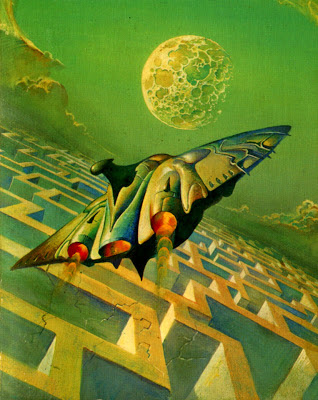The blesh are members of the Alliance in the Orion Spur. Unique among the Alliance species (and rare in the known galaxy), the blesh are gestalt beings, a blending of human and nonhuman.
Appearance and
Biology: Physically, the blesh are six-limbed bipeds, with some vaguely
insectoid features. They appear to made of crystal, with translucent bodies within which their organs (like strangely-shaped decanters) can be glimpsed. They
are likely either the bioroid creations or descendants of a long dead species. Blesh
do not reproduce sexually, but are instead grow like fruit from specialized cybernetic
“trees” on their homeworld.
History: Until
their “Great Awakening,” the bioroids were a post-sapient species; they had
long ago broken the strange-loop of self to live edenic lives in the tranquil gardens of
the totally controlled biosphere of their homeworld. All their needs were
provided by the techno-organic trees they tended. Sometime in the dark age
following the Great Collapse, a slower-than-light ark, launched from Old Earth
long ago, crashed on their world. The trees dutifully downloaded the refugee
human minds from the ark and (reading the ark's purpose) began distributing the
minds to their charges/gardeners. The blending of the human minds and the minds
and bodies of the bioroids formed the merged entities who call themselves blesh.
Psychology:
There were 1803 human minds recovered from the ark. Every blesh is one of
these minds blended with a bioroid post-sapient to form a new consciousness.
They name themselves by combining the name of the human mind, a number
designation related to the tree they grew from, and a monosyllabic prefix.
Blesh are a peaceful species with respect for other sophonts. They have not
historically been explorers, but they believe their culture to be enriched by
learning about other species, and they are interested in galactic stability.
Perhaps from the human elements in their minds, they have a great curiosity
about ancient human artifacts. Though the blesh have the memories of the human part of their composite mind, these memories belong to someone long dead and have for them a dream-like quality; they feel like visions of the past rather than events actually experienced.
Stats:
Blesh have a minimum Intelligence and Constitution of 9. Due to their synthetic
biology, they have a +1 to saves against most poisons and diseases. Their
integument provides AC 7 against weapons Tech level 3 or less. Their bodies
heal slowly, however, without the aid of their engineered trees (+1 to all
roles for length of time required for healing).










.jpg)




























